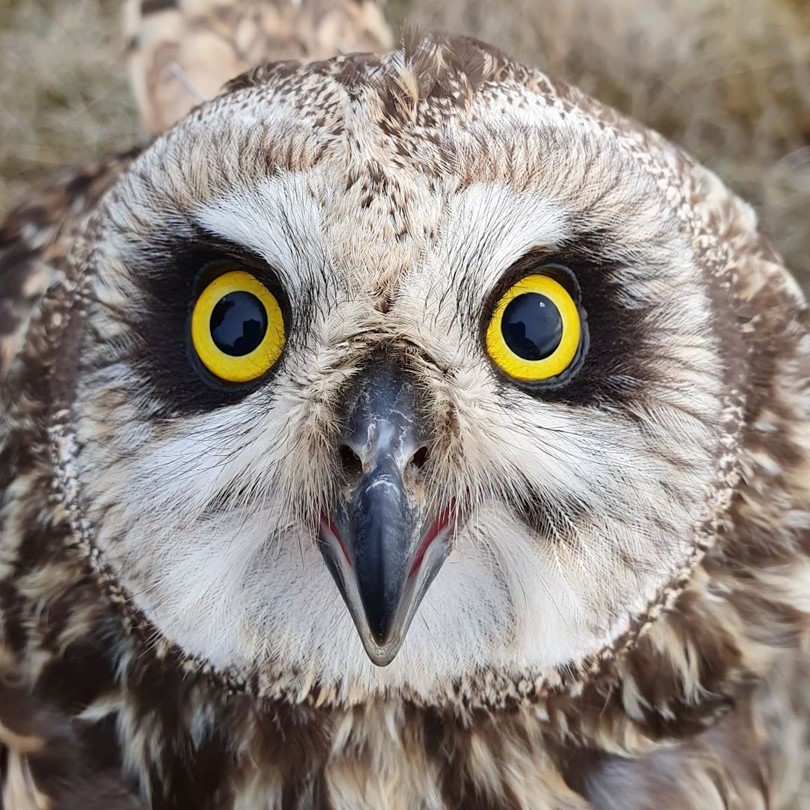By accepting you will be accessing a service provided by a third-party external to https://educom.net/
Life-threatening nomadic behaviour of the Short-eared Owl
While this might sound like the lifestyle anthem of the toughest rockers of the 1970s, a recent groundbreaking study by ornithologists shows that the life of the Short-eared Owl follows this path. The findings, published a few days ago in the scientific journal Ibis, reveal unexpected routes taken by the owl, and reveal the urgent need for coordinated conservation efforts for this elusive species on a much broader scale than previously thought.
Mysterious movements of the Short-eared Owl
Little is known about the lifestyle of the Short-eared Owl, which breeds in Iceland, but the owl's nature to appear in large numbers some years and disappear entirely in others, has fascinated both scientists and bird enthusiasts for a long time. The mystery has also raised questions that have proved challenging to answer. This elusive behaviour has not been thoroughly investigated until now, with collaboration between scientists from the British Trust for Ornithology (BTO), the University of Iceland, and the Spanish Research Council (CISC). Among the scientists and authors of the Ibis article, which has attracted considerable attention, is Gunnar Þór Hallgrímsson, professor of zoology at the University of Iceland.
The Short-eared Owl is known as a breeding bird throughout most of Europe, but its distribution is unstable. The fluctuation is believed to be due to unpredictable food supply, as Short-eared Owls specialize in hunting rodents such as mice. Their prey is influenced by various external factors, including seasonal variations, weather conditions, and geographical locations. The food resource for Short-eared Owls is thus highly unpredictable, fluctuating significantly over time and space. Although the owl can switch to alternative prey if necessary, its likely response is to venture into the unknown to search for something better. Until now, investigating this wanderlust of the Short-eared Owl has been complicated, but technological advances have allowed Gunnar Þór Hallgrímsson and his colleagues to gather new data using GPS trackers, shedding light on previously hidden aspects.
"I love owls, and they repeatedly inspire me to to explore and understand their lives. When you look into the eyes of an owl, you immediately sense mystery and want to know more. The unpredictable lifestyles of owls add even more excitement to the mystery," says Gunnar Þór about this magnificent bird.
New GPS devices were revolutionary
Gunnar Þór has been tagging Short-eared Owls in collaboration with scientists at the University of Iceland. Gunnar Þór has captured the owls sitting on their nests or caught them while foraging in flight, attaching new types of small gps transmitters to monitor them through satellites and map their nesting areas and movements.
The tagged birds in Iceland have been wide-ranging within Iceland, with some flying to Europe. The same was done by Gunnar Þór's collaborators in Scotland and Spain. The travels of 47 individuals marked in these countries were followed, and their journeys proved incredible. Birds marked in Scotland and Spain were not only widely found within Europe but some even flew to North Africa. A bird marked in Iceland flew to the British Isles, and after the article was written, another flew from Iceland to Norway and nested there.
The study also revealed that the same breeding owls often find a place to nest far from the breeding grounds they used in the previous year. The distance between nesting sites of the same individual ranged from 41 to 4,216 kilometres! There is no other known bird species where individuals can have such vast distances between their nests.
The migration of these birds has thus a significantly different pattern from other migratory birds that breed in Iceland. It is, for example, highly unlikely that a Short-eared Owl that nested in Úlfarsfell two years ago will nest there again, according to data from this study. Two female owls were marked with only a two-kilometre separation on the island of Arran in Scotland in 2021. One owl flew to Norway to breed the following summer, and the other flew to the Pechora Delta in the northern regions of Russia. It was also surprising in the study that a female owl marked on her nest in Scotland in 2017, nested twice in the summer of 2018; first in Scotland and then in Norway. This discovery shows that bird conservation needs to consider a broader perspective than previously thought. Coordinated monitoring of Short-eared Owls should ideally cover the entire continent to gain a comprehensive overview of the status of the population.
Sacrificial behaviour for the sake of new generations
"It involves costs to travel so extensively in search of suitable nesting sites because journeys on unknown paths are dangerous. But in some cases, the risk of the journey is worth it, as the owls find areas with sufficient food, thus potentially providing many young with a chance for life. However, this lifestyle results in only about half of the adult birds surviving on average throughout the year," says the scientist.
Another intriguing aspect of this new study was the behaviour of female owls during breeding. In sixteen out of the eighteen successful breeding attempts studied, the female owl left the family before the chicks were independent. The female owl thus left the male owl to complete the upbringing, while the male owls brought food to the owlets until they became entirely self-sufficient several weeks after they fledge.
"We cannot stop now!" says Gunnar Þór when asked about the progress or the next steps in the research on Short-eared Owls, which few see although they breed here, as they appear to stay off radar. They do not seek the limelight.
"The insight we gained into the spectacular life of the Short-eared Owl using GPS devices has raised many new questions that we need to seek answers to. Short-eared Owls are so unpredictable that they will undoubtedly continue to surprise us," concludes the scientist.
https://english.hi.is/news/life_threatening_nomadic_behaviour_of_the_short_eared_owl


 How to resolve AdBlock issue?
How to resolve AdBlock issue? 

